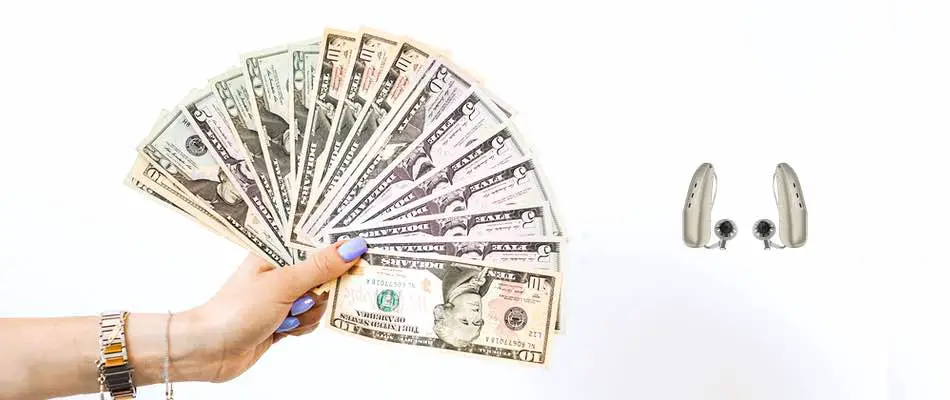Hearing aids are expensive. New technology gets combined with highly trained staff and the end result is devices that are worn for a lot of years and can be highly customized to the needs of the wearer. In this article, you will learn why hearing aids are so expensive and why they do not seem to go down in regards to the price.
The reason for the high price points is the model of distribution. Hearing aids still require highly trained staff which require continuous training in order to fit the little devices. People compare the hearing aids oftentimes with consumer electronics like phones which do not require a technician to verify if the product is a good fit for you or not. So the interaction with the consumer is very minimalistic in combination with usually no service appointments after the customer bought the device.
But when it comes to hearing aids the fitting requires a substantial amount of explanatory support during the sales process and even years after the wearer bought the hearing aids. In such a case the acoustician/audiologist has to invest a lot of time and money to make hearing aids work using best practices.
When you deal with a seller like shops on the internet the costs for hearing aids can be lower due to less service, less time spends, and no equipment needed for fitting the hearing aids. And hearing aids need maintenance every three to six months. The filter needs to be changed. The fitting needs adjustments due to a progression of the hearing loss or anatomical changes.

Why Are Hearing Aids Overpriced?
Hearing aids continually improved with new technologies to make your hearing better. The manufacturers need to spend hundreds of millions of dollars to make hearing aids more powerful and smaller.
While the actual device is actually built out of a computer chip two microphones and a speaker which cost the manufacturer approximately under 100$. The actual components do not make a hearing aid. Only research and time spent with the audiologist will lead to a satisfied hearing aid wearer.
What calculates in is the extensive service which means you can always come back to the shop. This of course is a mixed calculation because some wearers of hearing aids need a lot of time to complete the fitting and answer all the questions and others do not.
Are Expensive Hearing Aids Worth It?
Having more expensive hearing aids does not mean you can necessarily hear better with them. Oftentimes results are very similar when it comes to the understanding of speech when the acoustician compares expensive and less price intense hearing aids side by side.
However, the comfort of hearing can still be better. Let us say the wearer is in a very noisy environment and a loud noise distracts the wearer from a conversation. Wouldn’t it be better if the hearing aid would do a slightly better job so hearing fatigue sets in later for the wearer? For some people, it is worth the extra cost and for others not. Some people even experience a better understanding but for others who tested both no difference can be heard.
How Much Does It Really Cost to Make Hearing Aids?
Here in the table below you can see an estimate of the cost of the parts of a hearing aid. You can pretty easily find prices for the components used for the most. But there are also parts you can find like the processors which are developed directly by the manufacturers. As you can see the total cost for the parts of a hearing aid is estimated at 62,26$. Depending on the prices for the parts bought in bulk and the costs of the processor the price will vary.
| Microphone | 21,18$ / 17,94 € |
| Receiver | 27,20$ / 23,03€ |
| Bluetooth LE Module | 11,54$ / 9,77 € |
| Processor | 2,34$ – 236,15$ / 1,98€ – 200€ |
| LEDs | 0.05$ / 0.04€ |
| Case | 0.04$ / 0.03€ |
| Total cost fot the Parts of a hearing aid (minimum) | 62,26$ / 52.72€ |
A lot of buyers ask the question in my shop. What does it really cost to make a hearing aid? But that question is irrelevant as you will not get a working hearing aid by only having the parts. There are a lot of professionals working hard to make the components work together. And after the whole hearing aid is built it needs to be pushed to the market with advertisements. But before this can be done there are a lot more costs despite the cost for the electronics.
It is getting approval to sell medical devices in a certain market. The manufacturers need to pay consultants and lawyers worldwide for certifications needed for the specific market. And that alone adds millions of costs to the actual costs of a hearing aid that a consumer can not see. But of course in the end this raises the total price of a hearing aid. And with one hearing aid model added to the lineup, multiple certifications need to be made because of the modular way the hearing aids are built.
A different receiver requires another certification as wells as a device with a rechargeable battery or with a replaceable battery.
I hope you now have a better understanding of why hearing aids are so expensive. Headlines like the one below from CBC News are always pulling the attention from the consumers to the high price points of hearing aids. But at the same time, people want to have an improvement when they buy hearing aids again.

Would be the cost much lower if no improvements would have been added in the last decades? Sure. But Hearing aids from thirty years ago also had less acceptance than the devices sold today. They are simply obsolete and with the permanent upgrades when it comes to new Bluetooth protocols and ways to connect your hearing aids to your phone the cycle for improvements needs to be faster which requires more research.
I hope you have a better understanding of why hearing aids cost what they cost.
